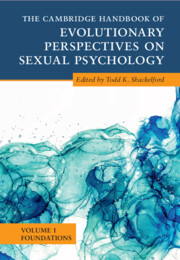Book contents
- The Cambridge Handbook of Evolutionary Perspectives on Sexual Psychology
- The Cambridge Handbook of Evolutionary Perspectives on Sexual Psychology
- Copyright page
- Contents
- Contributors
- Preface
- Part I Foundations of Evolution
- Part II Middle-Level Theories
- 7 Parental Investment Theory
- 8 Parent–Offspring Conflict
- 9 Theory and Evidence for Reciprocal Altruism
- 10 Life History Theory and Mating Strategies
- 11 Sperm Competition Theory
- 12 Sexual Conflict Theory
- 13 Cross-Species Comparisons
- 14 Cross-Cultural Methods in Sexual Psychology
- 15 Behavioral Genetics
- 16 Sex Differences and Sex Similarities
- 17 Individual Differences in Sexual Psychology
- 18 Experimental Methods in Sexual Psychology
- Index
- References
17 - Individual Differences in Sexual Psychology
from Part II - Middle-Level Theories
Published online by Cambridge University Press: 30 June 2022
- The Cambridge Handbook of Evolutionary Perspectives on Sexual Psychology
- The Cambridge Handbook of Evolutionary Perspectives on Sexual Psychology
- Copyright page
- Contents
- Contributors
- Preface
- Part I Foundations of Evolution
- Part II Middle-Level Theories
- 7 Parental Investment Theory
- 8 Parent–Offspring Conflict
- 9 Theory and Evidence for Reciprocal Altruism
- 10 Life History Theory and Mating Strategies
- 11 Sperm Competition Theory
- 12 Sexual Conflict Theory
- 13 Cross-Species Comparisons
- 14 Cross-Cultural Methods in Sexual Psychology
- 15 Behavioral Genetics
- 16 Sex Differences and Sex Similarities
- 17 Individual Differences in Sexual Psychology
- 18 Experimental Methods in Sexual Psychology
- Index
- References
Summary
Much of evolutionary psychology has focused on species-typical behavior or sex differences. However, recent attention has turned to considering the role of individual differences in shaping human behavior, in particular in the realm of sexual strategies. While some research still focused broadly on sex differences, there is a growing body of work that examines within-sex differences in sexual strategies. This work includes genetic and environmental influences on individual differences factors including flexible responses to ecological contingencies such as sex ratio and mortality rates. These within-sex individual differences can be divided into directly selected individual differences in mating strategies (genetically influenced biases toward developing longer-term or shorter-term mating relationships), indirectly selected individual differences in mating strategies (variations in mating strategy that might be influenced developmentally by individual differences in strategically relevant traits), indirectly selected individual differences in mating strategies that are influenced developmentally by external environmental contingencies (which could include environmental unpredictability or resource scarcity), and combinations of all three acting concurrently in one individual. This chapter will examine all three options and some of the evidence collected to date on their role.
Keywords
- Type
- Chapter
- Information
- Publisher: Cambridge University PressPrint publication year: 2022



